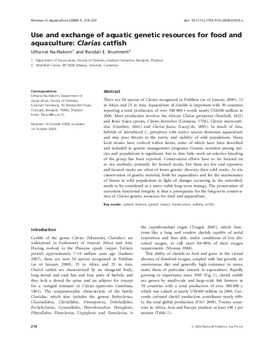Use and exchange of aquatic genetic resources for food and aquaculture: clarias catfish

Citation
Na-Nakorn, U.; Brummett, R.E. (2009). Use and exchange of aquatic genetic resources for food and aquaculture: clarias catfish. Reviews in Aquaculture 1(3/4): 214-223
There are 58 species of Clarias recognized in FishBase (as of January 2009), 33 in Africa and 25 in Asia. Aquaculture of clariids is important with 30 countries reporting a total production of over 300 000 t worth nearly US$400 million in 2006. Most production involves the African Clarias gariepinus (Burchell, 1822) and three Asian species, Clarias batrachus (Linnaeus, 1758), Clarias macrocephalus (Günther, 1864) and Clarias fuscus (Lacep'de, 1803). In much of Asia, hybrids of introduced C. gariepinus with native species dominate aquaculture and may pose threats to the purity and viability of wild populations. Many local strains have evolved within farms, some of which have been described and included in genetic management programs. Genetic variation among species and populations is significant, but to date little work on selective breeding of the group has been reported. Conservation efforts have so far focused on ex situ methods, primarily for farmed stocks, but these are few and expensive and farmed stocks are often of lower genetic diversity than wild stocks. In situ conservation of genetic material, both for aquaculture and for the maintenance of fitness in wild populations in light of changes occurring in the watershed, needs to be considered as a more viable long-term strategy. The preservation of ecosystem functional integrity is thus a prerequisite for the long-term conservation of Clarias genetic resources for food and aquaculture.
Permalink
Date Available
Type
Publisher
ISSN
1753-5123
Research Themes
Topics
Language